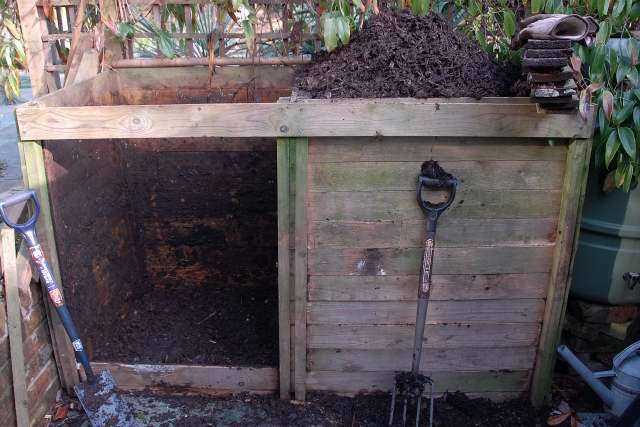The Best Compost Bin Design
Capacity
The best compost bin design for the cool climate tropical garden needs to have plenty of capacity. At the end of the growing season your tropical garden will provide lots of stuff to compost. There will be all the leaves from Ensete Ventricosum that have been dug up to overwinter. Any bananas will have had their leaves removed prior to being wrapped. Then comes the frost and all the tender tropical foliage plants will have been zapped and will need composting. All in all this requires a lot of room.

The best compost bin designs allow easy access to the compost.
Construction
For the garden featured on this site a double bin system is in operation. Each bin has a volume of approximately 1cubic metre. At times it is a struggle to get everything in. However lots of jumping up and down (on the compost) generally gets you through the tough times. As a result of this jumping up and down the compost bins need to be of sturdy construction.
Ventilation
Some of the literature on compost bin designs recommend wooden bins with large ventilation gaps (an inch or so) between the boards. This is theoretically to prevent the compost heap from over heating during decomposition. As discussed elsewhere it is quite rare for the domestic compost heap to reach prolonged high temperatures. Even when the compost heap has been filled to the brim at the end of the season, the plant material is so wet that it does not heat up significantly. During the late winter phase of pruning trees, shrubs and cutting back grasses etc., some considerable heat is generated, but I have yet to go to the bottom of the garden to find a crater where the compost bins once stood. All that gaps achieve is to leave you with dry strips of un-composted material when you come to turn the compost over.
Accessibility
The best compost bin design allows easy access to the compost. This does not mean through some opening the size of a letter box. Even some of the new bigger compost bins made from recycled plastics still insist on restricting your access. These designs rely on the assumption that you will occasionally scrape out a bit of compost from the bottom and the rest will collapse down. The best compost bin design will allow for the entire front to be removed. With the double bin system, the mature compost can be removed in one go. The compost can be piled on and empty border and used when planting. The front panels are then be replaced and the front panels from the second bin removed. The compost is then transferred into the empty bin. As each bin is emptied completely you are able to wash and re-treat the inside of the bin with a wood preservative.
Location
Another factor to consider is the location of the compost bins. The natural tendency is to place them as far out of sight as possible. This of course tends to be as far as you can get from the kitchen door. One thing to remember is that you will be making regular trips to the compost heap throughout the year delivering the kitchen scraps. Make sure you will not have to wade through mud during the winter to access your compost bin. If this happens your enthusiasm for composting may diminish. The best compost bin location will have some sort of paved pathway leading to it.
Also to consider when locating your bins is how easy it will be when it comes to emptying them. Place them somewhere that will allow easy access by wheel barrow. Emptying and turning the compost heap is quite an energetic process. You do not wish to be frustrated by cramped conditions.
When it comes to filling your compost bin:
- Left handed people should use the left hand bin for filling and the right for maturing.
- Right handed people should use the right side for filling and the left side for maturing.
This makes life easier when it comes to turning the contents of the 'filling' side into the 'maturing' side.

